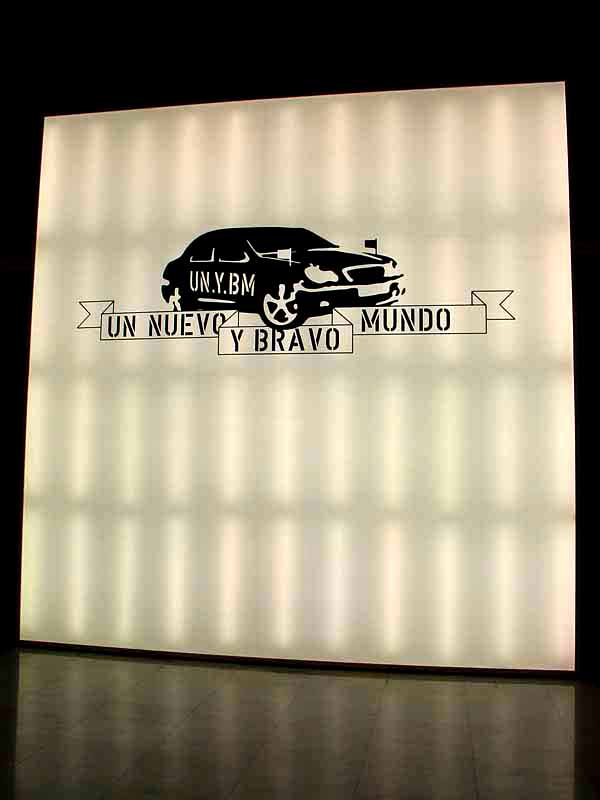Portfolio
- 7.291
- Tapiz 2024
- 21.759
- CRISIS?
- X
- Y
- Z
- Fortaleza Europa
- Horizonte de sucesos
- Las Improbabilidades Infinitas II
- Las Improbabilidades Infinitas
- Resistencia III
- Resistencia II
- R de resistencia
- Ne Travaillez Jamais
- Alguien Ahí
- El Gen Rojo
- Herramientas de Construcción Nacional I
- Juarez Sound System
- Un Pais Un Ejercito
Links
Lo Importante Es Participar


ENGLISH BELOW
Es ésta una consigna de fácil aplicación en cualquier ámbito, desde el social al publicitario, una interpelación al ciudadano para que actúe, pero con un significado similar a «el medio es el mensaje» de MacLuhan: no es tan importante el fin como el movimiento. De hecho se puede hablar de un intento de clausura mediática de la máxima política tan cuestionada (pero a la vez tan aplicada) de Maquiavelo: el fin justifica los medios. Enterrar un debate impopular tras la avalancha de las imágenes y la interactividad.
Desde la promesa de la interactividad (y en su relación con la virtualidad) se proyecta la actual proliferación de la imagen y abunda en la controversia sobre su capacidad para convertir lo real en un «todo ficticio» .
Si los registros de lo real (fotografías, películas de cine) vuelven compleja la relación entre lo real y su representación –entre lo real y lo ficticio–, ya que dicho registro puede ser más o menos subjetivo pero siempre es parcial, (pues reenvía al imaginario de quién toma las imágenes y al imaginario del receptor de las mismas); ésta situación se vuelve aún más compleja cuando cuenta con las transformaciones del espacio, pues remite a la construcción de una división del mundo entre los que miran y los que son mirados, aunque no necesariamente vistos (esto lo podemos comprobar en la industria del entertainment, en la imagen televisada entendida como acontecimientos organizados «para ser vistos» y en la ideología del turismo en general).
Nuestra relación con la imagen y sus técnicas contemporáneas son recíprocas, así la existencia de una industria cinematográfica tiene influencia sobre los gustos y los imaginarios que la han hecho posible. Por otro lado es evidente que los medios de comunicación y los desarrollos tecnológicos ejercen una influencia considerable sobre la organización del guión, sobre la posición de los actores y de cierta manera sobre el mismo estatuto de la ficción.
Es en la incorporación del espacio representado dónde se instala esta propuesta, dentro de la lógica de las peripecias artificiales, de los trucajes mediáticos, cuando cualquier interpretación de una crisis «objetiva» dentro de lo social se plantea del mismo modo que una escenografía de una película de catástrofes.
En este contexto planteamos un espacio lúdico consisten en una galería de tiro donde el espectador podrá «interactuar» , disparando sobre las imágenes proyectadas que recogerá una cámara de circuito cerrado desde la vía pública.



ENGLISH TEXT
«Ammunition Deli Gallery» is a shooting range where the spectator interacts by firing at projected images picked up in real time from the street outside by a closed circuit camera. The user vicariously becomes a sniper. The exhibition was announced with a bill posting campaign around Madrid and Barcelona. A photographic record of this campaign is also on show at the gallery together with a series of videos in spot format, setting out three models of civil participation in society under the slogan «Participating is what counts» .
» This motto is easy to apply in any realm from the social through to advertising, a call to citizens to act, but with a meaning similar to McLuhan’s «the medium is the message»: the end is less important than the movement. We can even talk of an attempted media bar on Machiavelli’s much questioned (but widely applied) maxim: the end justifies the means. Burying an unpopular debate under an avalanche of images and interactivity.
Starting from the promise of interactivity (and of its relationship with virtuality) it looks at the current proliferation of the image and explores the controversy over its ability to turn the real into «all fiction».
We have reciprocal relations with the image and its contemporary techniques; just as the existence of a film industry influences the tastes and the stock of images that made it possible. Also, the mass media and technological developments clearly have a large influence over the organisation of the script, the position of the actors and, in some sense, even the status of the fiction.
This proposal is about the incorporation of represented space within the same logic as artificial events or media tampering, when any interpretation of an «objective» crisis in the social sphere is approached in the same way as the set design of a disaster film.
If the recording of reality (photographs, films) makes for a complex relationship between the real and its representation – between fact and fiction, since the record may be more or less subjective but is always partial (remitting to the image stock of the person who took the images and the image stock of their receiver), the situation turns more complex still when it includes the transformation of space. Evoking the construction of a division in the world between those who look and those who are observed.»



